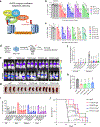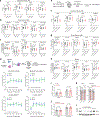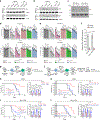Silencing of LINE-1 retrotransposons is a selective dependency of myeloid leukemia
- PMID: 33833453
- PMCID: PMC8270111
- DOI: 10.1038/s41588-021-00829-8
Silencing of LINE-1 retrotransposons is a selective dependency of myeloid leukemia
Abstract
Transposable elements or transposons are major players in genetic variability and genome evolution. Aberrant activation of long interspersed element-1 (LINE-1 or L1) retrotransposons is common in human cancers, yet their tumor-type-specific functions are poorly characterized. We identified MPHOSPH8/MPP8, a component of the human silencing hub (HUSH) complex, as an acute myeloid leukemia (AML)-selective dependency by epigenetic regulator-focused CRISPR screening. Although MPP8 is dispensable for steady-state hematopoiesis, MPP8 loss inhibits AML development by reactivating L1s to induce the DNA damage response and cell cycle exit. Activation of endogenous or ectopic L1s mimics the phenotype of MPP8 loss, whereas blocking retrotransposition abrogates MPP8-deficiency-induced phenotypes. Expression of AML oncogenic mutations promotes L1 suppression, and enhanced L1 silencing is associated with poor prognosis in human AML. Hence, while retrotransposons are commonly recognized for their cancer-promoting functions, we describe a tumor-suppressive role for L1 retrotransposons in myeloid leukemia.
Conflict of interest statement
Competing Interests Statement
The authors declare no competing interests
Figures
















Comment in
-
Retrotransposons: Jump to Cancer?Trends Cancer. 2021 Jul;7(7):577-579. doi: 10.1016/j.trecan.2021.04.004. Epub 2021 May 13. Trends Cancer. 2021. PMID: 33992534
References
-
- Kazazian HH Jr. & Moran JV The impact of L1 retrotransposons on the human genome. Nat Genet 19, 19–24 (1998). - PubMed
-
- Burns KH Transposable elements in cancer. Nat Rev Cancer 17, 415–424 (2017). - PubMed
-
- Lander ES et al. Initial sequencing and analysis of the human genome. Nature 409, 860–921 (2001). - PubMed
Methods-only References
Publication types
MeSH terms
Substances
Grants and funding
LinkOut - more resources
Full Text Sources
Other Literature Sources
Molecular Biology Databases
Research Materials

